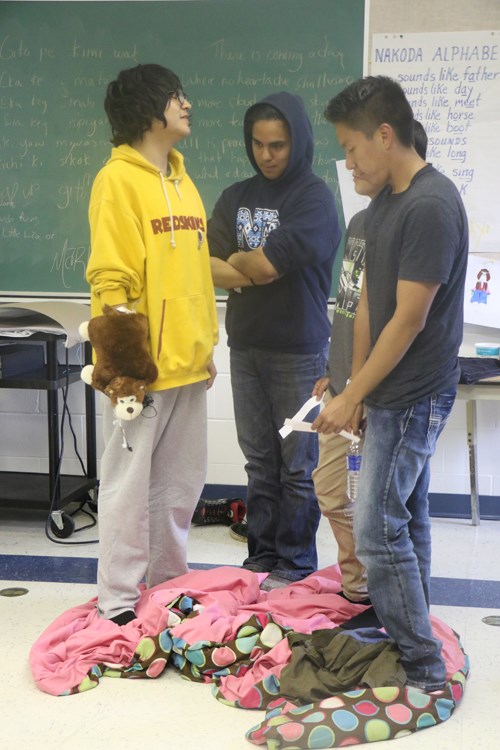It’s an exercise that would be beneficial in all schools, Lauren Pinacie-Littlechief – facilitator – explains of the Blanket Exercise.
               The intention of the exercise is to look at the history of First Nations peoples and the European settlers, how treaties were formed, and how the relationships changed as time progressed – moving from a mutually respectful living with a thriving trade this turned to initiatives focused on assimilation of First Nations people.
               As the exercise moved through each historical marker, the striking and emotional moments unfolded as people were told to leave their blankets – that they had died of a disease, died in a war, or their connections to family and land were broken.
               The exercise followed the progression of historical relationships starting with the Doctrine of Discovery, which saw Europeans discover the New World and decide to inhabit and explore the new land. At first there was a lot of cooperation and the settlers recognized that there were many independent Nations already living on the land. Treaties were made as a way to determine how people would share the land, water, plants, and animals moving forward.
               The Royal Proclamation of 1763 declared that Indigenous peoples owned their own land and that it had to be purchased from them in the form of Treaties. Through the War of 1812 relations remained positive and the British forces fought alongside First Nations against the invading Americans.
               As time continued the entire Beothuk people were killed; First Nations and Metis then suffered through the Red River Rebellion and the Northwest Resistance; while many were killed by European diseases, which their immune systems were not able to fight.
               During this time the term “civilized” was adopted in regards to land use, which led to a loss of living and culture amongst the First Nations people.
               In 1867 the British North American Act was passed and shortly after, in 1876, the Indian Act was introduced. There were limits to culture and how the family was seen; as well as restrictions to movement, culture, and religion.
               Enfranchisement led to the loss of legal Indian status under the Indian Act if individuals chose to pursue Western occupations such as teacher, lawyer, doctor, and even soldiers.
               The exercise then looked to Residential Schools for its legacy of pain; while it also drew attention to the 60s Scoop which saw Indigenous children placed with non-Indigenous families.
               More recently there has been a focus on the Missing and Murdered Indigenous Women, which was also addressed during the blanket exercise.
               Although there have been a few small steps forward in relations such as the Truth and Reconciliation Commission, Shannon’s Dream for First Nations to have a safe and comfy school to learn in, and the United Nations declaration of rights which focuses on “ensuring Indigenous people are alive and thrive,” as Pinacie-Littlechief explained.
               Following the exercise a discussion was held regarding what people thought and felt of it.
               “It was scary as you were on your blanket and people were asked to go sit down, I kept thinking if I’d be next, and I was quite disappointed when I was asked to leave my blanket,” one of the participants said.
               Another added, “I learned a lot about the history and events. It was interesting and very emotional; it blew my mind in a way because there were things I didn’t know about or things I did know, but didn’t know were that bad.”
        Â




